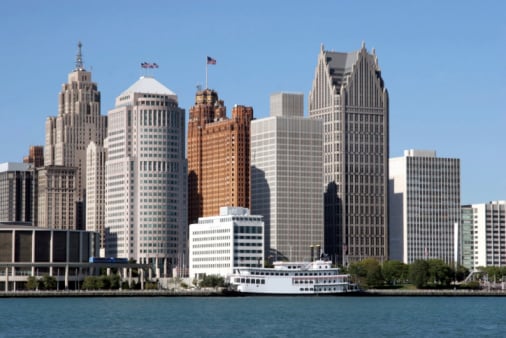Bankruptcy (Chapter 9) may have bolstered Detroit’s balance sheet by ridding it of billions of dollars in debt. The media have begun to cover events that point to a resurrection of the city, a process dubbed Detroit 2.0. However, unless Detroit can get back its residents, or find new ones, it will lack the tax base, and the ability to drive improved infrastructure, that will leave it in an economic twilight. Source: Thinkstock
Source: Thinkstock
Detroit has a population of 680,000 residents. That is down from 1.8 million in 1950 and 1.5 million in 1970. The U.S. car business began to lose market share to the Japanese in the 1970s. As that trend accelerated, car companies moved factories outside the city or closed them. Car quality perception and union costs made matters worse. The life blood was slowly sucked out of the city.
The resurrection of Detroit is an illusion. The population is not growing. According to the Detroit Free Press:
Detroit continues to lose residents, but the population loss appears to be slowing, with about 1% moving out between 2013 and 2014, according to estimates released today by the U.S. Census Bureau.
In the tri-county area, the Oakland County suburbs of Lyon and Oakland townships and Sylvan Lake, as well as Macomb and Washington townships in Macomb County grew the fastest, according to the estimates.
ALSO READ: America’s Most Segregated Cities
Apparently, some Detroit residents have not moved too far away. They have migrated to suburban cities that are only miles from Renaissance Center in the heart of downtown, one of the most visible attempts at a Detroit comeback. Finished in 1977, the project was led by Ford Motor Co. (NYSE: F) CEO Henry Ford II and financed partially by his car company. Ironically, it is now home to the General Motors Co. (NYSE: GM) headquarters. The project failed to pull large numbers of people to live in the center of the city.
The fact of the matter is that most of the people who have stayed in Detroit are poor. According to data from The American Community Survey, the median household income in Detroit is about half the national average of just over $50,000. The poverty rate is about three times higher. The city is in the midst of bulldozing thousands of houses.
Part of the myth about the Detroit comeback is that the city has started to rebuild its infrastructure and city services. A symbol of this is that many of the broken or burned out street lights have or are being replaced. However, Detroit is still “under-policed” and crime remarkably high.
A city cannot tax people who do not have money, and taxes on the small number of healthy businesses is a barely better path to raise city income. In all probability, Detroit has to give some sort of tax breaks to lure businesses into the city. Put simply, Detroit’s tax base is not enough to turn around the city.
Detroit’s unlikely turnaround, Detroit 2.0, becomes more unlikely by the day.
ALSO READ: 10 Cities With the Worst Traffic
Essential Tips for Investing: Sponsored
A financial advisor can help you understand the advantages and disadvantages of investment properties. Finding a qualified financial advisor doesn’t have to be hard. SmartAsset’s free tool matches you with up to three financial advisors who serve your area, and you can interview your advisor matches at no cost to decide which one is right for you. If you’re ready to find an advisor who can help you achieve your financial goals, get started now.
Investing in real estate can diversify your portfolio. But expanding your horizons may add additional costs. If you’re an investor looking to minimize expenses, consider checking out online brokerages. They often offer low investment fees, helping you maximize your profit.
Thank you for reading! Have some feedback for us?
Contact the 24/7 Wall St. editorial team.



